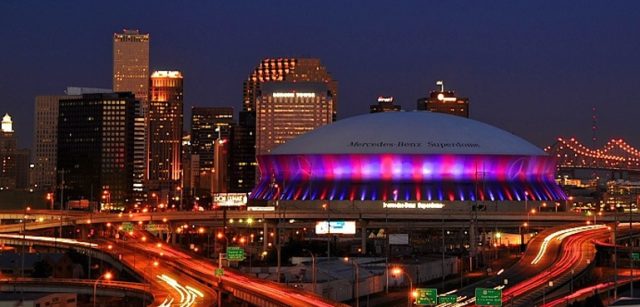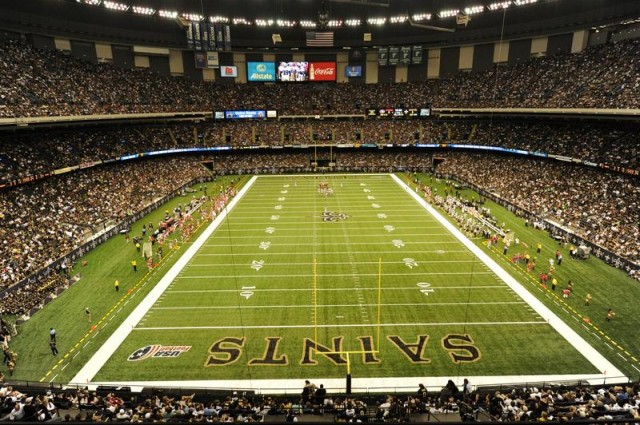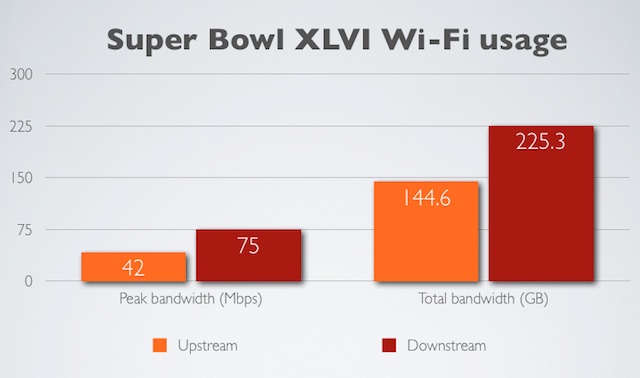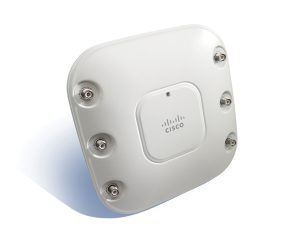
When 73,208 fans file into the New Orleans Superdome for the Super Bowl on Sunday, they'll have to follow the usual rules: no booze, no weapons, no fireworks, and no food (though food and beer can be purchased inside the stadium at exorbitant rates).
They'll also be prevented from bringing in any wireless equipment that might interfere with the proper workings of the Superdome Wi-Fi network. Lots of time and money went into giving ticket holders a wireless connection that rivals the one in their living rooms, and the NFL doesn't want anyone messing it up.
"The NFL has a very robust frequency coordination solution in place," Dave Stewart, director of IT and production for Superdome management firm SMG, told me in a phone interview. "Every device that enters the building has to go through a frequency scan and be authorized to enter. At the perimeter the devices are identified and tagged. If they present a potential for interference, they are remediated at that moment. Either the channel is changed or it is denied access. It's all stopped at the perimeter for this event."
In Stewart's words, the goal is to prevent any "rogue access points or rogue equipment from attempting to operate in the same frequency" as the stadium Wi-Fi network ("rogue" as in "not under the control of the system administrators").
During the Super Bowl, the network will be able to handle up to 30,000 simultaneous connections, which should be enough.
It's hard to imagine fans, press, or stadium staff deliberately trying to sabotage Super Bowl Wi-Fi, but some may do so unintentionally. Interference can be produced by "everything from someone operating a network wireless camera to someone operating pyrotechnics equipment that utilizes wireless service to trigger their equipment," Stewart said. "Imagine if you were to bring in a wireless camera and that wireless camera is tuned to the 2.4GHz frequency range [also used by Wi-Fi] and is continually broadcasting a signal. Anything that's going to operate in the same frequency range has the potential to cause interference. Some of those interfering devices are minimal, but others are impactful."
The biggest concern, he said, comes from "non-Wi-Fi-compliant continuous broadcast devices such as wireless cameras."
The best defense against such "rogue" wireless networking is to prevent the wrong devices from coming into the stadium, but you can't stop everything. "You can't stop a laptop from coming in. Working press needs to use that," he said. Yet laptops can be problematic if their owners try to create their own private Wi-Fi networks. "Anyone who enters the facility with a laptop has the ability to become a rogue by going to ad hoc [wireless networking] mode," Stewart said.
That's why wireless security doesn't stop when the game starts; the Superdome will use spectral analysis equipment to detect interference. "We're always monitoring the network. So we have a plan in place if there is an interfering signal to identify that and remediate that problem," Stewart said.
So if you're broadcasting a rogue wireless signal, well, you might just get a tap on the shoulder from a Superdome employee. Isn't it more fun just to watch the game, anyway?
Is the TV timeout over yet?

Well, maybe not. The NFL manages to spread 60 minutes of clock time across three hours in a typical game. What with time running off the clock between plays and the typical play lasting about four seconds, an average game ends up with only 11 minutes of action. And given how long Super Bowl halftime shows last, the game might not be over till Monday.
So fans have plenty of time to check their e-mail, upload pictures to Facebook, or get instant replays and game-related information on their mobile devices. While the NFL's strict control over wireless equipment might sound draconian, it's in service of the greater good: Wi-Fi for everyone who wants it.
The Superdome already had one of the most robust cellular networks among football stadiums, because 18 months ago AT&T built a carrier-neutral distributed antenna system on site to boost mobile signals. But that wasn't enough. Cellular providers want Wi-Fi in places like the Superdome because it offloads traffic from the cellular network, and fans like it because they're less likely to drop their connections or wait for videos to buffer.
The Superdome (or the Mercedes-Benz Superdome, to get the branding right) previously had Wi-Fi—but only for staff, press, and systems like ticketing. "That was not getting us where the NFL wanted us to be relative to the Super Bowl needs," said Superdome General Manager Alan Freeman. The new, Super Bowl-scale Wi-Fi network was just put in this season, with trial runs in a couple of late-season Saints games and in the Sugar Bowl. The Super Bowl will be the first time the network is publicly advertised as available to all fans, so the load will be greater. No password will be required to get on the Wi-Fi network.
More than 700 wireless access points will distribute signals inside the Superdome. Another 250 access points will provide Wi-Fi outside the stadium, including in parking lots and in Champions Square. (Another 300 access points are in the adjacent New Orleans Arena, which hosts the city's pro basketball team.)
During the Super Bowl, the network will be able to handle up to 30,000 simultaneous connections, which should be enough. At last year's Super Bowl in Indianapolis, Wi-Fi from 604 access points supported 8,260 simultaneous connections at its peak, while 12,946 attendees were on the Wi-Fi at some point during the game. 225GB of data was downloaded and 145GB uploaded, with peaks of 75Mbps down and 42Mbps up. (We're told the cell network for all carriers at last year's Super Bowl handled another 560GB of data total, including downloads and uploads.) Usage is expected to be higher this year, but it's impossible to predict exactly how much it will increase.

Superdome management thinks it's ready. In testing, "We're constantly seeing 20Mbps up and 20 megs down in all areas of the building," Stewart said. "That, of course, will change depending on the load, but the system is backed up by multiple redundant links to the Internet."
Verizon Wireless built the Wi-Fi network, and all equipment used came from Cisco. The back-end of the network is handled by two Cisco Nexus 7000 Series Switches (with another two in the adjacent arena), Cisco 5500 Series Wireless Controllers, and Cisco's 5540 Adaptive Security Appliances. Access points are Cisco Aironet 3500 devices.
This isn't consumer gear (a business Cisco is getting out of); these are high-density access points, designed for stadiums, with directional antennas that send the signals to just the right places. The Superdome has a ceiling, of course, but it's far above fans' heads. If antennas weren't positioned correctly, signals could be wasted in all that empty air. Using directional antennas lets the Superdome "control the signal and have a seamless handoff from one section to another when a fan roams, or when someone comes online," Stewart noted.
We need more channels!
The network supports 802.11n and previous Wi-Fi protocols 802.11a, b, and g, using both the 2.4GHz and 5GHz bands. Unfortunately, many fans' devices are capable only of getting on 2.4GHz.

The 2.4GHz band has 11 channels that can be used for Wi-Fi in North America, but because the channels overlap, the Superdome uses just channels 1, 6, and 11. In the 5GHz band, with its 23 non-overlapping channels, the Superdome network can use just about every available channel (while making sure not to interfere with radar).
High-end mobile devices like the iPad, iPhone 5, and Samsung Galaxy S III support 5GHz. Newer versions of the Kindle Fire support 5GHz, too; Google's Nexus 7 Android tablet does not. Many phones are still stuck on 2.4GHz as well.
"We're very anxious and can't wait for everyone to get on 5GHz," Stewart said. Even better will be when the world moves on to 802.11ac networks and devices, because the next-generation protocol uses multi-user MIMO (multiple-input/multiple-output) to transmit signals more efficiently. But that's not happening soon. While some home routers support 802.11ac, they're not NFL caliber.
"There's no commercially available high-density 802.11ac equipment that I know of," Stewart said.
In a worst-case scenario, high numbers of fans streaming video could cause congestion and slow down fans' connections. "This is not unlimited. There's no such thing," said Kelley Carr, co-founder of Cellular Specialities, a consultant who helped oversee the design and implementation of the network for the big game.
What they have for the Super Bowl is probably good enough for this year, though. "We're all confident it will work, just based on our experience in the past," said Carr. "As long as 100 percent of the people in there don't take out their cellular device and switch it to the Wi-Fi network, it should be fine."
With an average signal strength rating of -60dB, fans in their seats should get a signal comparable to what they would have at home if they were sitting about 20 feet from their wireless router, Stewart said.
This will be the seventh Super Bowl to be hosted at the Superdome since 1978—and such access would have been unthinkable in any of the previous games. Freeman noted that "from a technological perspective, these mega-events keep getting more complex, exponentially in some cases, every year."
reader comments
79